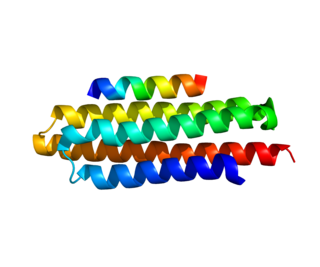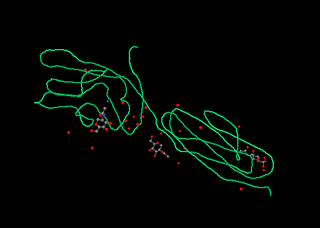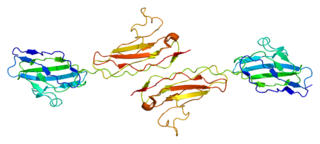
Paxillin is a protein that in humans is encoded by the PXN gene. Paxillin is expressed at focal adhesions of non-striated cells and at costameres of striated muscle cells, and it functions to adhere cells to the extracellular matrix. Mutations in PXN as well as abnormal expression of paxillin protein has been implicated in the progression of various cancers.

CD2 is a cell adhesion molecule found on the surface of T cells and natural killer (NK) cells. It has also been called T-cell surface antigen T11/Leu-5, LFA-2, LFA-3 receptor, erythrocyte receptor and rosette receptor.

Integrin-linked kinase is an enzyme that in humans is encoded by the ILK gene involved with integrin-mediated signal transduction. Mutations in ILK are associated with cardiomyopathies. It is a 59kDa protein originally identified in a yeast-two hybrid screen with integrin β1 as the bait protein. Since its discovery, ILK has been associated with multiple cellular functions including cell migration, proliferation, and adhesion.

Zonula occludens-1 ZO-1, also known as Tight junction protein-1 is a 220-kD peripheral membrane protein that is encoded by the TJP1 gene in humans. It belongs to the family of zona occludens proteins, which are tight junction-associated proteins and of which, ZO-1 is the first to be cloned. It was first isolated in 1986 by Stevenson and Goodenough using a monoclonal antibody raised in rodent liver to recognise a 225-kD polypeptide in whole liver homogenates and in tight junction-enriched membrane fractions. It has a role as a scaffold protein which cross-links and anchors Tight Junction (TJ) strand proteins, which are fibril-like structures within the lipid bilayer, to the actin cytoskeleton.

Probable G-protein coupled receptor 124 is a protein that in humans is encoded by the GPR124 gene. It is a member of the adhesion-GPCR family of receptors. Family members are characterized by an extended extracellular region with a variable number of protein domains coupled to a TM7 domain via a domain known as the GPCR-Autoproteolysis INducing (GAIN) domain.

G-protein coupled receptor 97 also known as adhesion G protein-coupled receptor G3 (ADGRG3) is a protein that in humans is encoded by the ADGRG3 gene. GPR97 is a member of the adhesion GPCR family. Adhesion GPCRs are characterized by an extended extracellular region often possessing N-terminal protein modules that is linked to a TM7 region via a domain known as the GPCR-Autoproteolysis INducing (GAIN) domain.

Carcinoembryonic antigen-related cell adhesion molecule 1 (CEACAM1) also known as CD66a, is a human glycoprotein, and a member of the carcinoembryonic antigen (CEA) gene family.

Junctional adhesion molecule A is a protein that in humans is encoded by the F11R gene. It has also been designated as CD321.

Cadherin-3, also known as P-Cadherin, is a protein that in humans is encoded by the CDH3 gene.

Contactin-2 is a protein that in humans is encoded by the CNTN2 gene.

Neurofascin is a protein that in humans is encoded by the NFASC gene.

Eukaryotic translation initiation factor 2-alpha kinase 1 is an enzyme that in humans is encoded by the EIF2AK1 gene.

Pre-B-cell leukemia transcription factor 2 is a protein that in humans is encoded by the PBX2 gene.

CUB domain-containing protein 1 (CDCP1) is a protein that in humans is encoded by the CDCP1 gene. CDCP1 has also been designated as CD318 and Trask. Alternatively spliced transcript variants encoding distinct isoforms have been reported.

Ligatin, otherwise known as eIF2D, is a protein that in humans is encoded by the LGTN gene. This protein is not a component of the heterotrimeric eIF2 complex, but instead functions in different pathways of eukaryotic translation.

Endosialin is a protein that in humans is encoded by the CD248 gene.

CCDC186 is a protein that in humans is encoded by the CCDC186 gene The CCDC186 gene is also known as the CTCL-tumor associated antigen with accession number NM_018017.

Cadherin 9 is a protein that in humans is encoded by the CDH9 gene.

FAM178B is a protein coding that is located on the plus strand of chromosome 2. The locus for the gene is 2q11.2. It is also known by the aliases Family with Sequence Similarity 178, Member B, and HSPC234. In total there are 24 exons in the gene. FAM178B spans 110,720 base pairs, and contains 827 amino acids.

Nader Rahimi is a Molecular Biologist and is currently an Associate Professor at the Department of Pathology and Laboratory Medicine at Boston University.



















